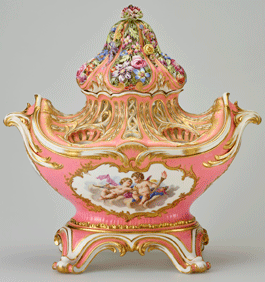From drawings by Leonardo da Vinci and a gardening manual owned by Henry VIII, to a metre-high clock in the form of a vase of flowers, a new exhibition exploring the garden in art opened in Edinburgh on Friday.
‘Painting Paradise: The Art of the Garden’ (at The Queen's Gallery, Palace of Holyroodhouse, until 26 February 2017) brings together more than 75 paintings, drawings, books, and decorative arts from the Royal Collection, a number of which have not been exhibited in Scotland before. From spectacular images of epic royal landscapes to jewel-like manuscripts and delicate botanical studies, it includes works by masters such as Leonardo da Vinci and Rembrandt van Rijn.
Shown in Scotland for the first time, a copy of the Ruralia Commoda, the world's first gardening manual, acquired by Henry VIII after the death in 1543 of its previous owner, Richard Rawson, the King's chaplain and advisor on his divorce from Catherine of Aragon, is on display. It was written in Latin between 1304 and 1309 by Petrus de Crescentiis, a wealthy lawyer from Bologna in Italy, and was the only publication of its kind during Henry VIII's reign.
Also displayed for the first time in Scotland is a book of verse by the Edinburgh-born artist Esther Inglis, illustrated with watercolour paintings of native species of flower, such as the thistle and buttercup. It was one of four works created by Inglis for the young Henry, Prince of Wales (the eldest son of James VI of Scotland and Anne of Denmark, who was brought up in Edinburgh) and is believed to have been presented as a New Year's gift in 1607.
A highlight of the exhibition is the magnificent Sunflower Clock, c.1752, produced in the 18th century by the Vincennes porcelain factory. The clock is made up of delicate porcelain flowers that surround a dial made from brass shavings to imitate the centre of a sunflower, a symbol of the Sun King, Louis XIV. A Sèvres porcelain pot-pourri gondole, 1757–8, for growing bulbs, acquired by George IV when Prince of Wales, was once displayed in the dining room of Carlton House, the Prince's London residence.
Painting Paradise includes works on paper that chart the rise of botanical art. Leonardo da Vinci's pen-and-ink drawing of Job's tears, c.1510, shows the artist's desire to understand the structure and growth of plants as part of his wider interest in examining the scientific forces underpinning the whole of nature. Six delicate works by Alexander Marshal, c.1650-82, represent the phenomenon of the florilegium, a celebration of the plants in a particular collection or garden. Marshal's work is the only surviving paintedflorilegium from 17th-century England.
In the Victorian period, the garden was often used as the backdrop for portraits of the Royal Family. A painting by Franz Xaver Winterhalter from 1850 shows Queen Victoria nursing her third son, Prince Arthur, on the Pavilion Terrace at Osborne House on the Isle of Wight. The composition echoes the traditional image of the Madonna and Child in a garden, while the setting reflects the latest fashions in horticulture. It includes an Agave americana, a succulent from Mexico, which was among the many rare species collected by botanists and introduced into Victorian domestic gardens.
Also explored in the exhibition is the theme of the 'sacred garden'. Adam and Eve in the Garden of Eden, 1615, is one of a series of 'Paradise landscapes' by the Flemish artist Jan Brueghel the Elder. The exquisite painting by Rembrandt van Rijn of Christ and St Mary Magdalene at the Tomb, 1638, depicts the New Testament story of Mary Magdalene mistaking the resurrected Christ for a gardener.